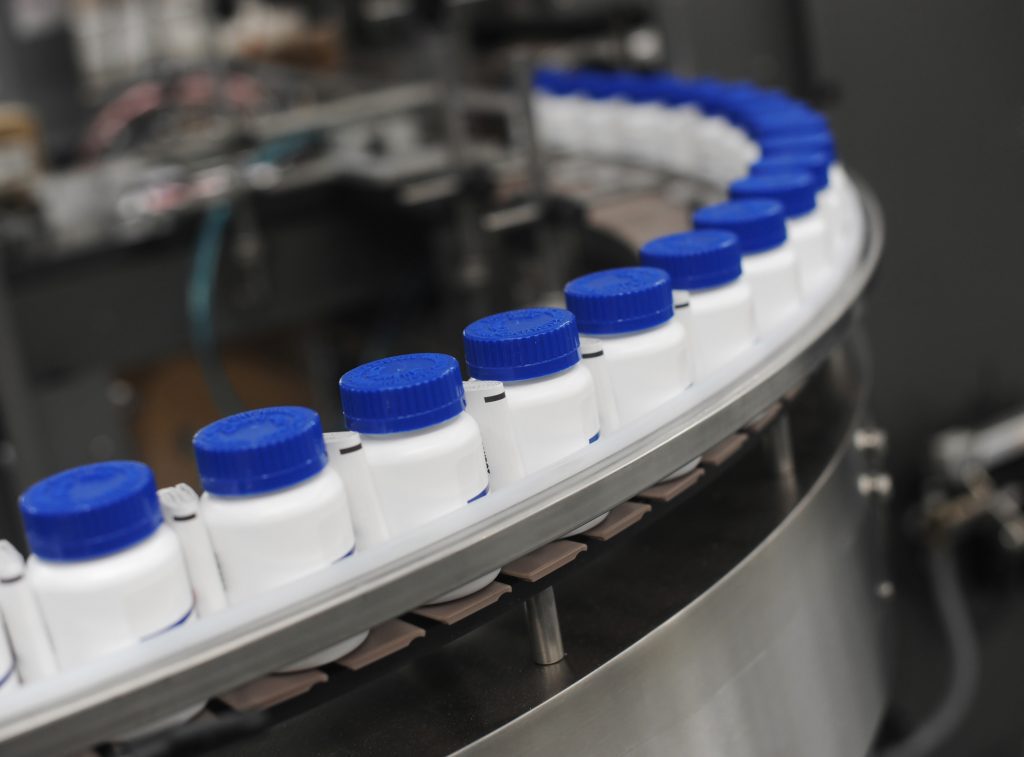Pharmaceutical Packaging Supply Chains: 5 Agile Features for Powerful Outcomes
One of the many lessons learned from the challenges of the pandemic the value of agility. Organizations, businesses, and industries that maintained nimble supply chains through the uncertainty of COVID-19 not only managed short-term risks and disruptions, but are also in a position to meet new market conditions for years ahead.
Packaging Supply Chain Agility in Pharmaceuticals
While agility is often associated with speed, and speed is certainly an aspect of agility, supply chain agility speaks to much more. More accurately, it is the ability to adapt both quickly and easily to constantly changing packaging supply chain conditions.

Streamlining Healthcare: Automated Conveyor System Ensuring Efficiency in the Pharmaceutical Packaging Supply Chain.
Benefits of Agility
When applied to the pharmaceutical industry, and specifically drug packaging, agility has positive and meaningful results.
Maintaining sales momentum
It is well known that significant time and cost are required to develop and commercialize high-quality, efficacious pharmaceutical products. Once a product is launched, companies will look to maximize revenue streams for as long as possible using different strategies, such as entering new geographical markets, supporting conversion from a prescription to over-the-counter (OTC) product, or launching sales and marketing campaigns with promotional samples – all of which could require new packaging solutions. Agile packaging operations that provide multiple options and solutions such as blister packaging and serialization, ensuring that products meet market requirements promptly help customers sustain sales momentum.
Stabilizing your business
Pharmaceutical companies are increasingly looking to partner with contract packaging organizations (CPOs). This partnership not only improves the stability of the pharmaceutical company as they refocus on their core strengths, but also allows CPOs to invest in their operations to further improve market stability. Additionally, CPOs typically have diverse packaging supply chain solutions as a result of a wide clientele base. When choosing partners with whom to work, agility enhances stability in the packaging supply chain sector.
Ensuring reliable supply amidst change
As we have all heard before, the only constant is change, but can your supply chain meet that change – not if change happens, but when change happens? CPOs that react quickly to unexpected change and still meet customer obligations ensure pharmaceutical products reach the intended market without delay despite extenuating circumstances. In other words, reliability is absolutely critical in choosing a packaging partner.

Features of an Agile Drug Packaging Supply Chain
Volumes have been written about pharmaceutical packaging operations, with many more to come. However, this article is focused on what makes operations more agile. There are five features:
Outcomes-Oriented Approach
The Packaging Supply Chain plays a critical role in delivering efficacious drug products to the patients who need them. While in general, the intended health outcomes for patients using medications remain consistent, the specific business goals for each drug product can vary greatly based on the patient or consumer base, geographic dispersion and market conditions – and all of these factors have an impact on packaging.1
Clear communication of customer requirements to the CPO allows for better-refined project timelines, management of packaging capabilities and any potential changes in supplier requirements that may be needed. Critical to maintaining agility is clearly understanding the project goals during the initial technical transfer, as they form the starting point for developing any contingencies and backup plans that can be activated when changes do occur.
Anticipating Forecast Changes
Pharmaceutical forecasting, especially for new drug products, is a complex and difficult task, and often inaccurate.2 It is important for packagers to expect changes in forecast models – not just causing product quantity to change, but also packaging designs, labeling requirements, or configurations.
This anticipatory mindset combined with the other features of agile drug packaging operations listed here can enable drug developers and their CPOs to adjust quickly and easily to change.
Establishing Supply Chain Diversity
Using an established and diversified material supplier base enables contract packagers to build robust contingency plans in the event any single supplier is unable to deliver materials on time.
While this does not entirely prevent the risk of disruption to drug product packaging and distribution to patients and consumers, packaging supply chain diversity can certainly mitigate the risk of disruption. Establishing relationships with suppliers who mirror your own organization’s emphasis on responding to change quickly and easily is also important.
Vertically Integrated Capabilities
Vertically integrated capabilities deliver reliability and agility and can foster strategic partnership networks that greatly reduce the time from concept to commercial solution.
Let’s use home-based information technology as an example. It was not long ago we had different service providers for telephone, cable television, internet, and home security. It is not uncommon now to have a single provider for all these services – in other words, one vertically integrated supplier, one point of contact for all problems and quick change requests, and one bill.
This model also contributes to the agility of contract packaging supply chain operations. Consider the variety of packaging formats for prescription and over-the-counter (OTC) drugs and how a forecast change can initiate a significant chain reaction. Perhaps a project that was 100% focused on bottling a product changes to include a 40% mix of blister packs for the drug product as well. In this case, a pharmaceutical company would either need to invest in a blister line or find another CPO with that capability. Both options are costly and time-consuming. Instead, consider using a contract packaging partner with diverse capabilities to support quick and easy adjustment should packaging needs change.
Capacity Management
Packaging capacity management requires comprehensive situational awareness of all packaging projects, a deep understanding of capabilities, and knowledge of packaging turn-over and preparation times. Capacity management also requires close coordination with packaging supply chain managers, packaging designers, labeling artwork specialists, and packaging process engineers. A certain amount of packaging line capacity may also need to be reserved to offer flexibility for surge capability when needed. Similar to the outcomes-oriented approach featured above, developing contingency plans is important to understand possible scenarios that would change existing packaging projects, and what capabilities might be needed to support changes. Thinking through these change scenarios in detail will position packaging operations to be more agile.

Navigating the Future of Distribution: A Business Professional Engages with a High-Tech Interface for Packaging Supply Chain Optimization.
Conclusion
Organizations with agile supply chains not only survived pandemic conditions but also readily adapted to the new normal that took shape. Agile organizations in the pharmaceutical industry flourished too, considering the speed at which COVID-19 vaccines were developed.
Contract packaging organizations and the customers they support can use the agile packaging supply chain to sustain sales momentum of commercialized products, create organizational stability and achieve outcomes reliably.
Important to consider are the five features necessary for an agile supply chain to ensure you realize these benefits, especially when choosing a packaging partner: an outcomes-oriented approach to planning, anticipating forecast changes, establishing supply chain diversity, vertically integrated capabilities, and flexible capacity management.

Team Collaboration in Action: Professionals Using Digital Tools to Enhance Efficiency in the Packaging Supply Chain.
-
“A Guide to Patient-Centered Healthcare Packaging,” Jones Healthcare Group (blog), February 19, 2021. https://joneshealthcaregroup.com/news/blog-a-guide-to-patient-centred-healthcare-packaging/
-
McKinsey & Co. looked at 1,700 analyst forecasts on 260 drugs launched from 2002 to 2011. They found that most forecasts were wrong, and more than 60% of them were way, way off--more than 40% over or under. A sizable number of the forecasts overstated the case by more than 160%. Forget drug-sales forecasts, study finds: They're mostly wrong | FiercePharma
